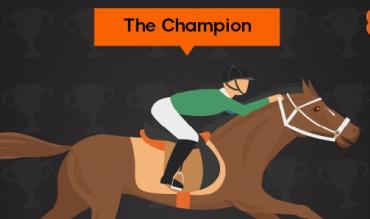Aside from the chance to find out which Ladies’ Day hats are visible from space, day three of Royal Ascot gives us the Ascot Gold Cup race – one of the highlights of the racing calendar.
Since 1807 runners and riders from across the world have raced for the Gold Cup prize, and one of the sport’s biggest prize pots – in 2016 a share of £400,000 was up for grabs over the two miles and four furlongs of flat course on the Ascot track.
With more than two centuries of sporting tradition to draw from, we’ve analysed the vital stats of each Gold Cup winner since 1917 to bring you the ultimate pick of the stables.
So if you’ve ever wondered the colour of the Gold Cup’s best-performing horses, or what’s behind those weird and wonderful names, our boffins have calculated the secret to Ascot success.
What’s in a name?
With four wins in a row at the end of the Noughties, and little if any connection to its namesake aside from Irish heritage, Yeats was the clear pick of racing talent at the Gold Cup. But throughout Gold Cup history, we found that Yeats was actually one of the more straightforward names chosen, what with racehorses’ unusual naming convention. Wallaby (1959) and Happy Man (1923) lend even less credence to the idea that there’s any method to the madness.
We split up the winners of each Gold Cup race into categories and found that one theme has produced more success than the rest. Beginning with Tangiers in 1920, right through to last year’s Trip to Paris, it seems that invoking the name of a place is the popular choice of so many winners; with 19 horses in the past century making up almost a fifth of the honour roll.
Vital statistics
Considering the type and colour of the Gold Cup’s winners has also thrown up some interesting results. Although early black-and-white footage of the races makes it deceptively difficult to tell, we’ve been able to find out that when it comes to horse racing, Bay is the colour.
Bay-coloured horses have won 62 of the 99 races we’ve covered – almost two-thirds. More typically described as a range of reddish brown colours, bay horses enjoyed strong periods of dominance in the 1940s, winning eight straight between 1941 and 1948. Bay horses also won 22 out of 29 races between 1981 and 2009 – only the winning chestnut Double Trigger in 1995 stopped that run from including 12 in a row.
Although featuring second-highest in the list, chestnuts like Double Trigger don’t come close to bay’s brilliance, winning only 22 races in our Royal recap. This despite placing first in six races spanning the 1970s and 1980s – though only three different horses crossed the finish line first in this instance.
In assessing the age and gender of the Gold Cup’s finest runners, you can’t dispute the success of the stallion – winning 71 races in the past century due to the rigorous staying demands of the course. Until the 1990s, its dominance was almost absolute. But beginning in 1991 we see a lot more variety in the winning horses, with the six-year old mare Indian Queen taking the honours. Following Drum Taps’ double in 1992 and 1993, it would be ten years before a stallion won again, with Mr Dinos finally restoring a stallion to the Gold Cup winners’ circle in 2003.
Location, location, location
Finally in uncovering our history of Ascot Gold Cup winners, we set out to determine whether or not each jockey’s place of origin had a part to play in guiding their trusty steeds across the winning line. With locations as far flung as the USA and Australia to choose from, we wanted to find the hotbed of horse racing success.
The Republic of Ireland has produced more winners than any other country in the past two decades, with 15 different races going the way of the Emerald Isle and 17 in all. With multiple winners Michael Kinane and Johnny Murtagh joining Kieran Fallon on the win list, Ireland has proved to be the true breeding ground of race talent since the dawn of the millennium. Going further back we see that Berkshire has a strong claim on the most successful jockeying joint – however, further research indicates that 11 of the county’s 15 wins were run by legendary jockey Lester Piggott alone.
The formula of racing form
Combining these findings, we’ve found the secret of Gold Cup success. If Lester Piggott doesn’t happen to be available on the day, your best bet may be to employ an Irish rider. The horse should ideally be a four-year old bay-coloured stallion, with a name that’s descriptive of a location. With these areas covered, you have the formula for an iconic win at this year’s Gold Cup race.


